National Islands Plan Survey: final report
This report presents the findings from the National Islands Plan Survey. The research explores perceptions of island life in relation to the strategic objectives set out in the National Islands Plan.
3. Main findings
3.1 Population
Most islanders say they plan to stay on the island for the next five years but report that it is not easy for young people (under 40) to live and work in their local area, with some variation between island groups.
Perceptions are more positive in Orkney and Shetland Mainlands and substantially more negative in Skye and the Small Isles, and Arran, Bute and the Cumbraes. Younger islanders tend to be more positive that it is easy for them to live and work in their local area, significantly more so than older residents.
Access to crofting is generally felt to be difficult, with low availability of croft tenancies and dissatisfaction with the support available for crofters.
3.1.1 Population growth
- 86% of islanders think they are likely to stay on the island for the next five years.
- Residents of the Shetland Outer Isles are most likely to think they will stay (93%) and residents of Orkney Outer Isles are least likely (79%); however, this was not a significant difference.
- Young islanders are significantly less likely to say they will stay (71%) compared to other age groups.
- Less than a third of island residents agree that it is easy for young people (under 40) who want to live and work in their local area to do so.
- More than half of respondents in Orkney Mainland (53%) and Shetland Mainland (52%) agreed with this statement. These are significantly greater when compared to Skye and the Small Isles (13%) and Arran, Bute and the Cumbraes (14%).
- Agreement with this statement declined with age. 39% of 18 to 19-year-olds agreed that it is easy for young people to live and work in the local area, significantly more than those aged 66 and over (23%).
- A quarter of island residents agree that young people are supported to remain, move or return to the local area.
- Agreement with this statement was low across all age groups.
- Orkney Mainland (39%) and Shetland Mainland (37%) had the highest levels of agreement, although not significantly greater than other subregions.
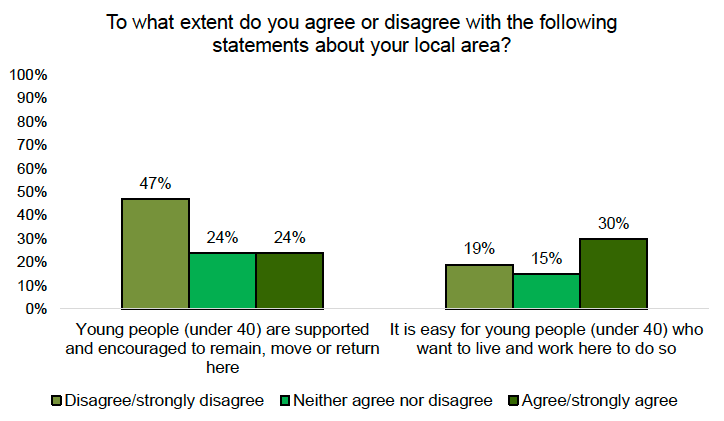
3.1.2 Perceptions of crofting
- 19% of respondents live and/or work on a croft or smallholding, including a significantly greater proportion of respondents from Uist and Barra (41%), Orkney Outer Isles (36%) and Shetland Outer Isles (36%) than the rest of the island subregions.
- 20% of island residents agree that there are vacant crofts in their local area, and 9% agree that people who want a croft tenancy can obtain one.
- There are significant differences between all regions regarding the availability of crofts. The highest levels of agreement are in Lewis and Harris, where more than half of respondents reported that there were vacant crofts and 22% that croft tenancies are available.
- 20% of islanders agreed that local crofters are adequately supported.
- Some disagreement with these measures may be attributed to lack of crofting knowledge among some respondents.
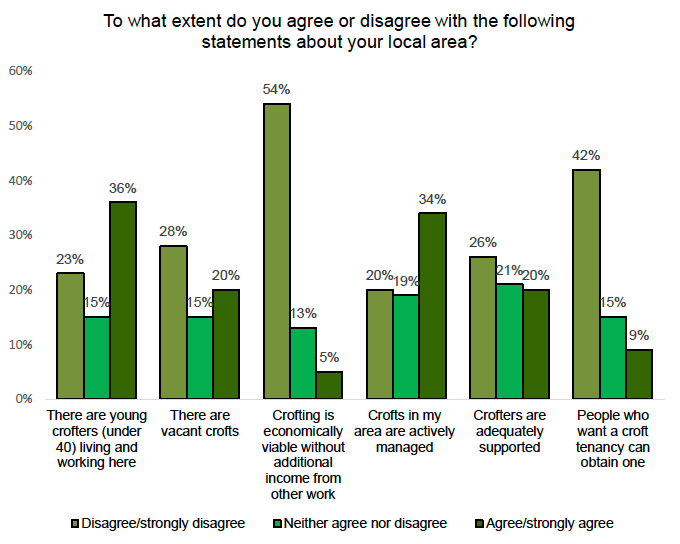
3.2 Sustainable economic development
Perceptions of the availability of jobs in fishing, agriculture, forestry, tourism and renewables, as well as support to find and keep jobs, varied greatly between the island groups.
There were large differences reported between Orkney Mainland, Shetland Mainland and their Outer Isles counterparts (Outer Isles residents generally feeling less positive).
Tourism is the sector that islanders feel most positive about.
Younger island residents are more positive than older island residents about the availability of job opportunities across all sectors.
3.2.1 Job opportunities and support
- Young people (aged 18 to 35) are significantly more positive about all measures of job availability, compared to other age groups (Figure 3).
- 31% of island residents agree that there are jobs available to suit different interests, skills and ambitions in the local area.
- A significantly higher level of agreement was reported by residents in Orkney Mainland (59%) than by residents of Orkney Outer Isles (15%). A similarly significant, albeit smaller, difference was noted between Shetland Mainland (42%) and Shetland Outer Isles (20%).
- Uist and Barra (15%), Skye and the Small Isles (16%), and Arran, Bute and the Cumbraes (16%) also recorded significantly lower agreement compared to the highest subregions.
- 48% of islanders believe that apprenticeships are available.
- Again, agreement rates significantly varied between Shetland Mainland (61%) and Shetland Outer Isles (32%), and Orkney Mainland (71%) and Orkney Outer Isles (12%).
- Perceptions of the availability of job opportunities in different sectors significantly vary between all island groups. Argyll Islanders were most positive about jobs in fishing and Orkney Mainland residents most positive about jobs in agriculture. Jobs in forestry were felt to be fewer, with Skye and the Small Isles residents most likely to report opportunities.
- 31% of island residents agree that there are job opportunities in low carbon and renewable energy.
- Highest agreement was reported by residents in Orkney Mainland (76%), whilst the Argyll Islands (6%), and Bute, Arran and Cumbrae (10%) reported significantly lower agreement.
- 46% of island residents agree that there are services available to help people find and keep jobs.
- Highest agreement was reported by Orkney Mainland residents (73%) whilst the Orkney Outer Isles reported significantly lower levels (15%).
- Lewis and Harris residents reported 54% agreement while Uist and Barra reported only 17% agreement.
- Significantly lower agreement was found in the Argyll Islands (9%) than the other islands.
- 30% of island residents agree that parents have access to childcare services that suit their work hours.
- Argyll Islands (9%) and Orkney Outer Isles (9%) have especially low levels of agreement.
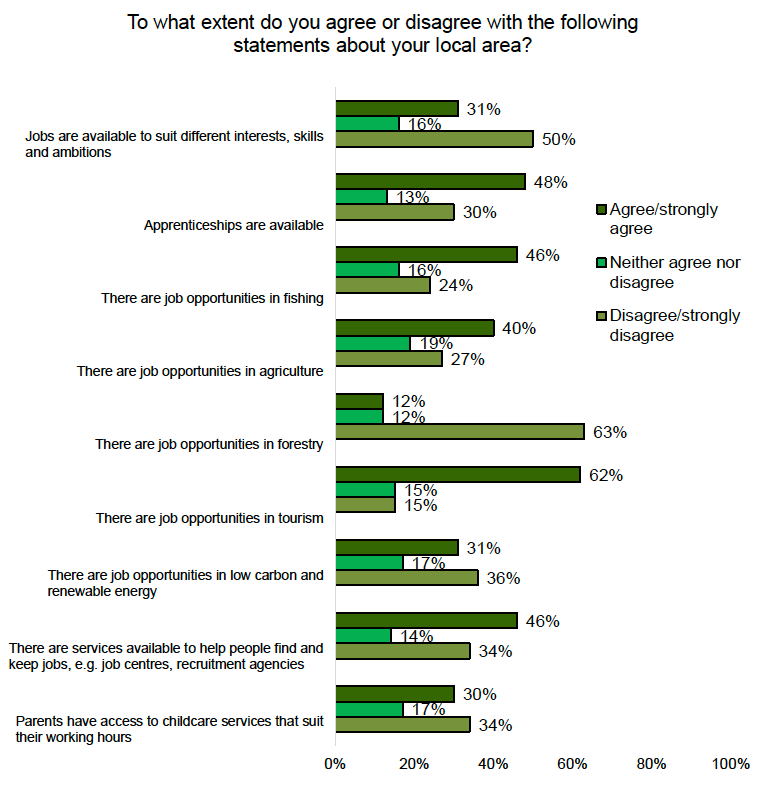
3.2.2 Business opportunities
- 21% of residents perceive that businesses in their local area are growing.
- Although there was no significant difference between all regions, the lowest agreement was reported in Uist and Barra (14%) and Lewis and Harris (15%).
- Highest agreement was reported in Orkney Mainland (29%) and Skye and the Small Isles (25%).
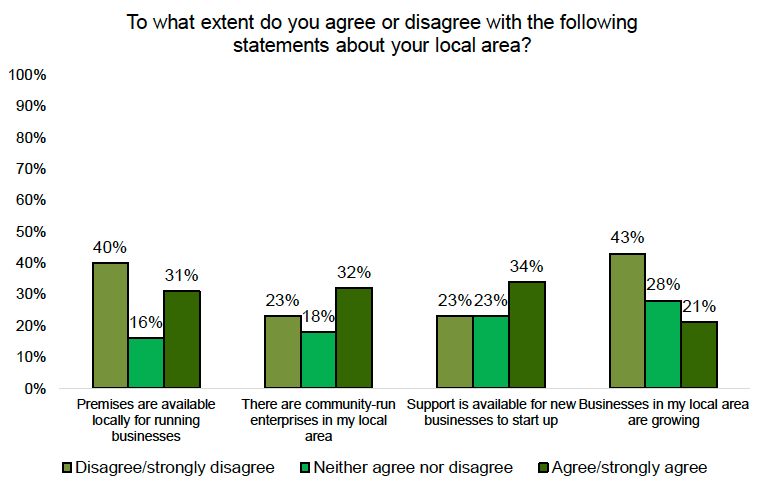
3.2.3 Tourism
- Tourism was perceived as a source of job opportunities across the islands, with significantly higher perceived availability in Orkney Mainland (81%), Skye and the Small Isles (81%) and Argyll Islands (74%). The lowest level of agreement that jobs are available in tourism was reported by Shetland Outer Isles (30%).
- Around three quarters of islanders perceive that the number of tourists visiting their local area has increased in the past 5 years and that it has a positive impact in their local area. However, a minority of residents (23%) feel that there is adequate provision for the number of tourists, with the significantly lower levels of agreement in Skye and the Small Isles (4%) than other islands.
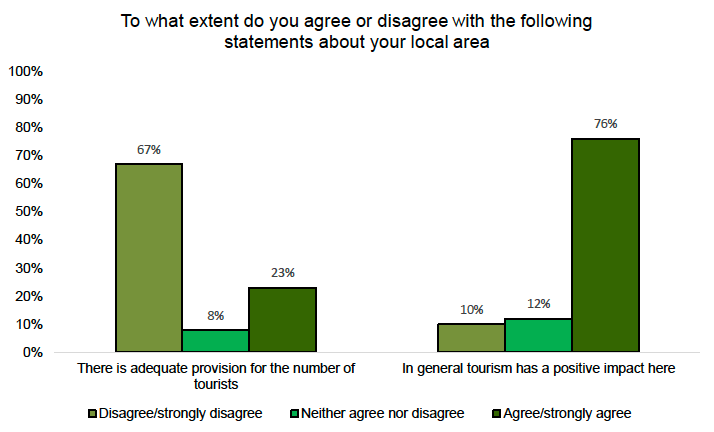
3.3 Transport
There was large variation between island groups with respect to the accessibility of island transport, with patterns of use dictated by island location and infrastructure.
For example, residents of Shetland and Orkney Outer Isles make greatest use of inter-island ferries, while residents of Mainland Shetland and Mainland Orkney make most use of flights to and from mainland Scotland. Compared to other measures, residents express least satisfaction with fares for both residents and visitors.
Access to buses was reported much more favourably in Orkney Mainland, Shetland Mainland and Lewis and Harris than in Orkney Outer Isles, Shetland Outer Isles and Uist and Barra.
Different patterns of transport use are notable between different age groups, with older people making greater use of local buses and mainland ferries, younger people flying to and from the mainland more often, and middle-aged residents (aged 36 to 50) making more use of inter-island ferries.
Older people were more likely to express dissatisfaction with roads, paths and pavements.
3.3.1 Public transport
General
- Just over a third of island residents say that it is easy to connect between different forms of transport when making journeys to or from their home.
- Arran, Bute and the Cumbraes has higher levels of agreement with this statement (60%), and Uist and Barra has significantly lower levels (9%).
Local buses
- Less than a third of islanders use buses more than once a year, with greatest use in Arran, Bute and the Cumbraes (50%), and significantly less use in Shetland Outer Isles (12%) and Uist and Barra (12%).
- People aged 66 and over make greater use of local buses compared to 52-65 year olds, with 42% of the 66 and over age group reporting that they use them more than once a year.
- Less than half of islanders agree that the local bus service runs when they need it and that fares are good value for locals and visitors. 52% say the service is reliable and that they can easily find out about routes and times. There are significant differences between all regions, with residents of Uist and Barra least likely to agree with these statements.
- Most island residents (80%) say they can access a bus within walking distance of their home.
- Residents of Arran, Bute and the Cumbraes (92%) were significantly more likely to agree than other regions.
- There were also significant differences between Orkney Mainland (88%) and Orkney Outer Isles (36%); Shetland Mainland (84%) and Shetland Outer Isles (43%); and Lewis and Harris (91%) and Uist and Barra (58%)
- 69% of islanders agree that their local bus connects to essential services, with significant differences between Orkney Mainland (81%) and Orkney Outer Isles (25%), and between Shetland Mainland (74%) and Shetland Outer Isles (33%).
Ferries to and from the mainland
- Overall, ferries to and from the mainland are the most frequently used form of transport for islanders.
- 96% of residents of Arran, Bute and the Cumbraes use mainland ferries more than once a year, and 20% use them more than once a week.
- Lower levels of use is reported from Skye and the Small Isles, where only 19% of residents use the ferry more than once per year.
- Across the islands, people over the age of 51 use mainland ferries significantly more frequently than those under 50. 69% of those aged 66 and over use them more than once a year.
- Two thirds of island residents agree that the mainland ferryservice runs when they need it, 58% that it is reliable and 64% that there is usually space when they need it. Less than half agree that fares are good value for locals and visitors.
- Island subregions had significantly different perspectives on reliability, with Arran, Bute and the Cumbraes having the lowest agreement that mainland ferries are reliable (35%).
- Residents also significantly differ on whether fares are good value, with Shetland Mainland (20%) and Shetland Outer Isles (23%) least in agreement.
Inter-island ferries
- Island residents significantly differ in their use of inter-island ferries.
- The greatest use of inter-island ferries is made in Shetland Outer Isles, with 98% of residents using inter-island ferries more than once a year and 47% using them more than once a week.
- Use is also high in Orkney Outer Isles, with 79% of residents using them more than once a year and 22% using them more than once a week.
- Across all island groups, the 36-50 age group made most use of inter-island ferries, with 51% using them more than once a year.
- Satisfaction with inter-island ferries is highest in Shetland Outer Isles, where 66% of residents say the service runs when they need it, 70% that it is reliable and 78% that there is usually space on board. Agreement drops with respect to fares being good value for residents (36%) and visitors (34%).
- Satisfaction with inter-island ferries in Orkney Outer Isles is lower, but not significantly. 54% of residents agree that the service runs when they need it, 60% that it is reliable and 59% that there is usually space. Agreement that fares are good value is lower, at 39% for residents and 37% for visitors.
Flights to and from the mainland
- Residents of Mainland Shetland and Mainland Orkney make most use of flights to and from the mainland, with 58% doing so more than once a year. This is significantly greater than residents of Arran, Bute and the Cumbraes, who had the lowest levels of use.
- Across the islands, younger people are significantly more likely to use mainland flights, with 49% of 18 to 35-year-olds using them at least once a year, compared to 27% of those aged 66 and over.
- 55% of island residents agree that mainland flights run when they need them, 45% that the service is reliable and 50% that there is space when they need it. Less than one in five residents feel the fares are good value.
Inter-island flights
- Use of inter-island air services differs across island subregions. The greatest use is in Orkney Outer Isles, with 35% of residents using this service more than once a year, followed by Uist and Barra (23%).
- Satisfaction with inter-island flights is generally low. However, significantly greater satisfaction levels were recorded in Orkney Mainland and Orkney Outer Isles, where 39% and 37% of residents say the service runs when they need it, when compared to the lowest satisfaction rates in Skye and the Small Isles.
- Of those living in Orkney's Outer Isles, 49% say the service is reliable, but less than a quarter of residents say there is space on the service when they need it. 38% feel fares are good value for residents, and just 19% feel they are good value for visitors.
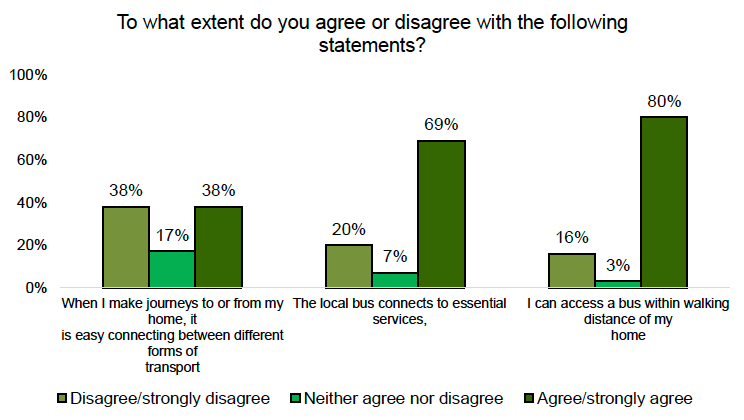
Table 4. Frequency of use of public transport
| Thinking about times before COVID-19 and lockdown (before March 2020), how often did you use buses, ferries and planes? | |||||
|---|---|---|---|---|---|
| Flights to and from the mainland | Inter-island air services | Ferries to and from the mainland | Inter-island ferries | Buses (on your own or a neighbouring island) |
|
| Service is not available | 16% | 18% | 1% | 7% | 4% |
| Never | 16% | 54% | 7% | 18% | 39% |
| Less than once a year | 12% | 12% | 9% | 16% | 16% |
| Once a year | 16% | 6% | 17% | 14% | 10% |
| Several times a year | 37% | 8% | 51% | 33% | 20% |
| At least once a month | 3% | 1% | 10% | 7% | 5% |
| At least once a week | 0% | 1% | 5% | 5% | 6% |
Table 5. Quality of public transport
| Which of these statements do you agree with? | |||||
|---|---|---|---|---|---|
| Flights to and from the mainland | Inter-island air services | Ferries to and from the mainland | Inter-island ferries | Local bus service | |
| The service runs when I need it | 55% | 23% | 66% | 45% | 44% |
| The service is reliable | 45% | 22% | 58% | 45% | 52% |
| There is usually space on the service when I need it | 50% | 21% | 64% | 48% | 59% |
| Finding out about routes and times is easy | 62% | 33% | 77% | 54% | 52% |
| The fares are good value for local residents | 19% | 13% | 42% | 33% | 45% |
| The fares are good value for visitors | 13% | 12% | 37% | 32% | 41% |
| I do not have access to this service | 7% | 12% | 3% | 6% | 5% |
3.3.2 Walking and cycling infrastructure
- Just over a third of island residents agree that roads, paths and pavements in their local area are in good condition, although responses may have been affected by the non-availability of paths and pavements in some areas.
- A quarter of island residents agree that their local roads and paths are safe for cycling, and safe and accessible for wheelchairs and prams.
- Shetland and Orkney Mainland and Outer Isles residents felt safest using local roads, paths and pavements, with more than half of residents agreeing they felt safe. This is significantly greater than Uist and Barra (21%), Skye and the Small Isles (22%) and Argyll Islands (24%), who all reported low agreement with this statement.
- People aged 66 and over people were less likely to report that roads, paths and pavements were safe compared to those aged 18 to 35.
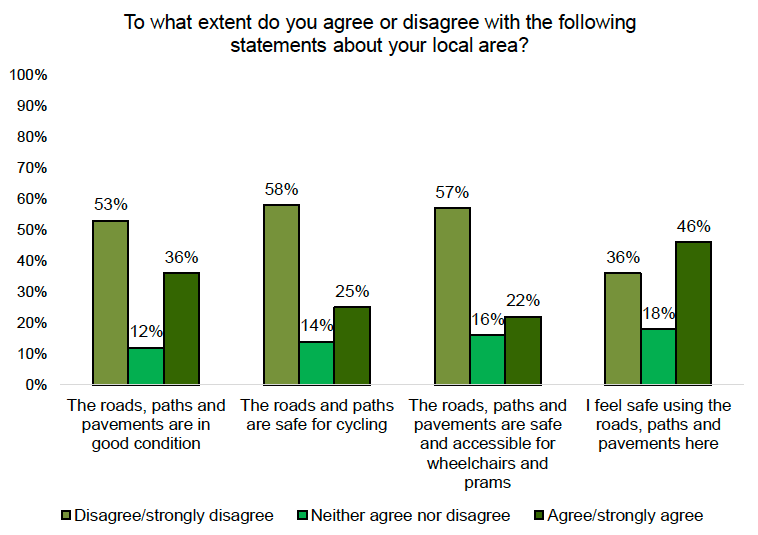
3.4 Housing
There is strong evidence of dissatisfaction with housing among respondents, with perceived poor availability of housing – and affordable housing – in many islands. In contrast, the majority of island groups reported high proportions of holiday and second homes.
3.4.1 Housing
- Less than half of island residents agree that there is a variety of housing types, sizes and tenures to meet people's needs.
- Agreement was significantly greater in Orkney Mainland (55%) and Shetland Mainland (54%), compared to much lower levels in Skye and the Small Isles (21%) and the Argyll Islands (22%).
- Just over a third of island residents agree that there is affordable housing locally.
- Agreement was significantly lower in Skye and the Small Isles (19%), Argyll Islands (20%), and Uist and Barra (20%) than other island regions.
- 19% of islanders agree that there is enough housing available to meet local demand.
- Argyll Islands (8%) and the Skye and the Small Isles (7%) had significantly lower levels of agreement.
- 45% of island residents agree that self-build is a viable option for home ownership, with lowest levels of agreement in Arran, Bute and the Cumbraes (23%), and significantly higher levels in Lewis and Harris (56%).
- 71% of island residents agree that there is a high proportion of local holiday lets and second homes.
- Agreement was generally high, with six of the nine island groups reporting between 75% and 90% agreement.
- Shetland Mainland (40%), Shetland Outer Isles (35%) and Orkney Outer Isles (39%) reported significantly lower agreement in comparison.
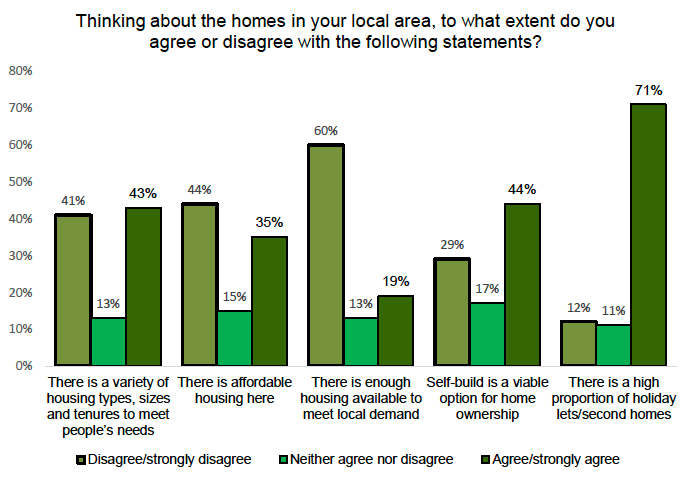
3.5 Fuel poverty
The majority of island residents reported that their heating bills had increased in the past year.
While most said that they could afford to keep their home warm, a significant minority could not and some had to choose between food and heating.
3.5.1 Fuel poverty
- 73% of islanders agreed that their heating bills have increased in the past year.
- 78% of people aged 66 and over reported an increase compared to 69% of 18 to 35-year-olds
- 71% of island residents agreed that they could afford to keep their home warm in the past year. 13% could not.
- Shetland Mainland had significantly lower levels of agreement (63%) than other regions.
- Over a third of island residents said that their home sometimes felt uncomfortably cold in the winter.
- 8% of island residents have had to choose between keeping their home warm and buying food or essentials for themselves and their family.
- An additional 4% indicated 'Prefer not to say' which may imply a higher level of fuel/food poverty.
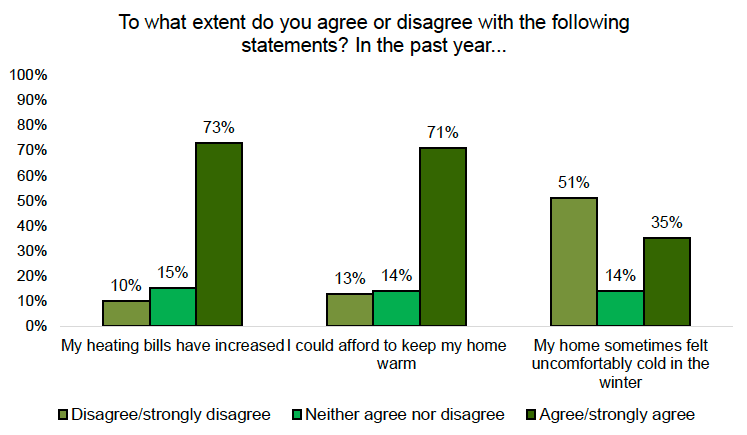
3.6 Digital connectivity
The majority of respondents could access the internet from home. However, speed and reliability of internet connections are an issue for many, particularly in Orkney and Shetland Outer Isles.
Mobile signals vary, with particularly poor reports from Orkney Outer Isles.
Islanders are generally confident in using the internet for most tasks, but slightly less so in attending online health and social care appointments.
3.6.1 Digital inclusion in Island communities
- 96% of island households have access to the internet from home.
- Older residents, aged 66 and over, report slightly but significantly lower levels of access than other age groups, at 92%.
- 65% of island residents agree that their internet connection at home is fast enough to do what they want online.
- Only 27% of Shetland Outer Isles residents agreed with this statement compared to 66% of Shetland Mainland residents.
- A significant difference was also noted between the Orkney Outer Isles (45%) and Orkney Mainland (70%).
- 62% of island residents agree that their internet connection at home is reliable, with significantly lower agreement in Shetland Outer Isles (30%) and Orkney Outer Isles (35%).
- Confidence in using the internet for various activities was high, with lowest confidence (52%) in attending health and social care appointments.
- 60% of island residents agree that there is a good mobile phone signal in their home, and 56% that there is a good signal in their local area.
- Residents of Orkney Outer Isles report significantly poorer mobile coverage (27% have a good signal at home, and 29% in the local area) compared to residents of Orkney Mainland (78% have a good signal at home, and 69% in the local area)
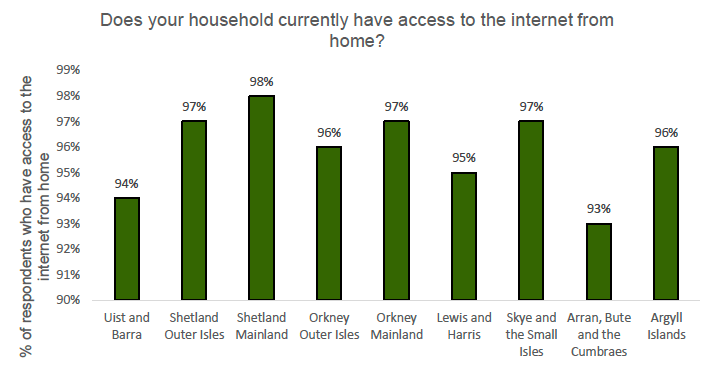
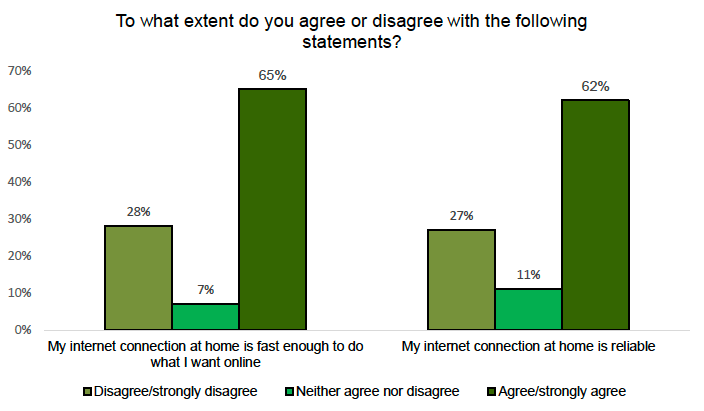
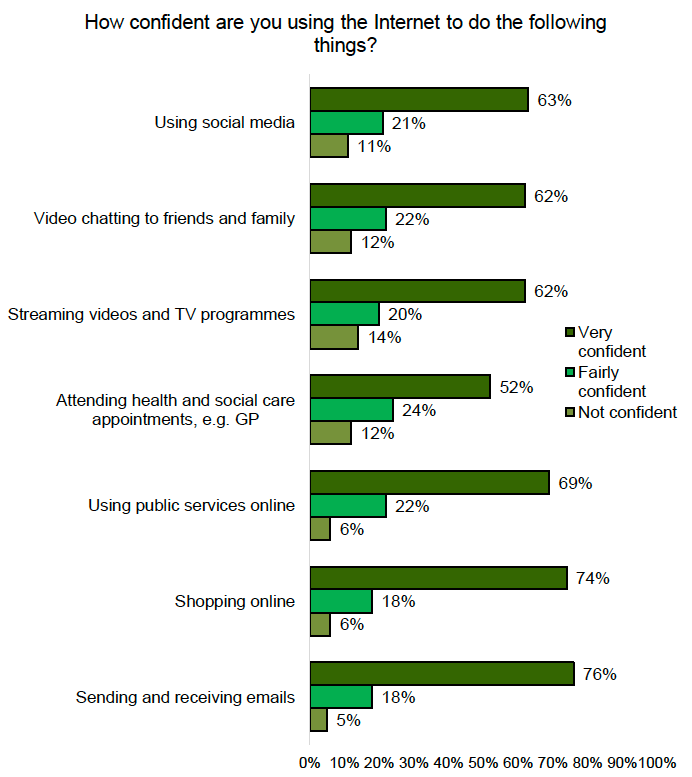
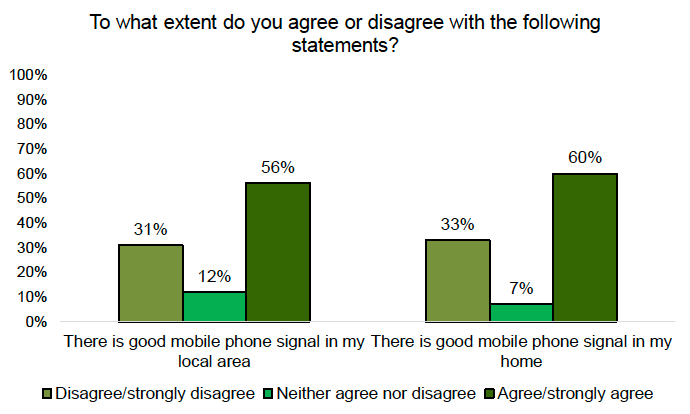
3.7 Health, social care and wellbeing
There are notable differences in reported levels of access to health, social care and wellbeing services between the island groups.
Almost all residents of Orkney Mainland and Shetland Mainland report that they can easily access a hospital, a dentist and a pharmacy. However, substantially fewer residents of Orkney Outer Isles and Shetland Outer Isles report this.
Argyll Islanders report notably lower satisfaction with local sports facilities than other island groups.
Perceived access to mental health services is low, with a large degree of uncertainty about what services are available.
A small proportion of respondents used food banks or food support schemes, although 'Prefer not to say' responses and subregion-level variation suggest that this figure may be higher than indicated.
3.7.1 Health and social care services
- Most island residents agreed that they could easily access a hospital, with notable differences between Orkney Mainland (95%) and Orkney Outer Isles (62%), Shetland Mainland (92%) and Shetland Outer Isles (62%). A similar pattern is evident with respect to dentists and pharmacies.
- A quarter of islanders agree that they could easily access mental health services.
- Levels of agreement significantly differed between the highest level in Lewis and Harris (32%), and the lowest in Shetland Outer Isles (18%).
- An additional 39% of island residents responded "don't know".
- A third of island residents have accessed a health or social care appointment online.
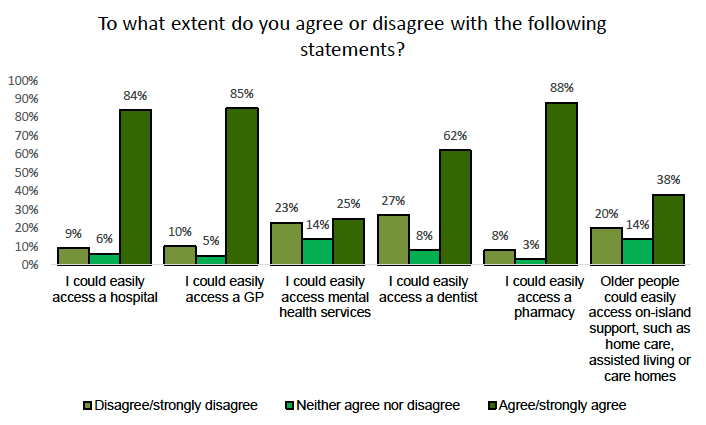
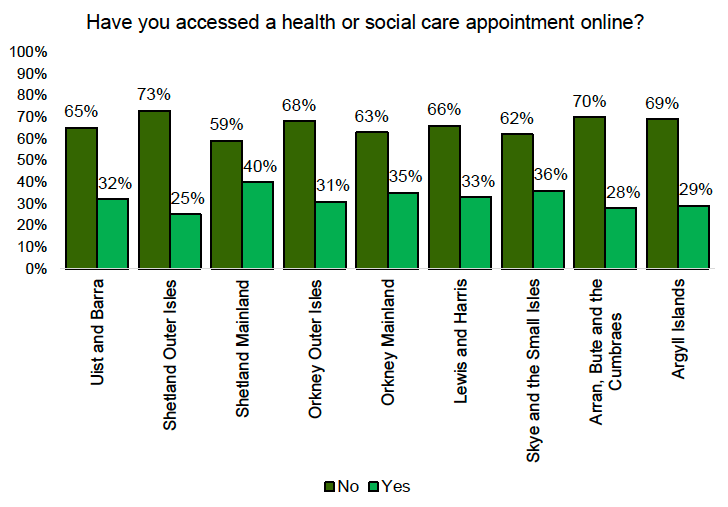
3.7.2 Physical activity in islands communities
- 86% of island residents agree that there are places where they can go to take part in sports and physical exercise.
- Island subregions differed greatly on the availability of places for sport and physical exercise, with Argyll Islands reporting lower availability than other islands with only 60% agreement.
- 73% of island residents agree that local sports facilities are good quality and well maintained.
- Argyll Islands had significantly lower levels of agreement than the rest of the islands at 36%.
- 59% of island residents agree that their sports facilities are affordable.
- Argyll Islands (40%) and Arran, Bute and the Cumbraes (44%) reported the lowest agreement with this statement.
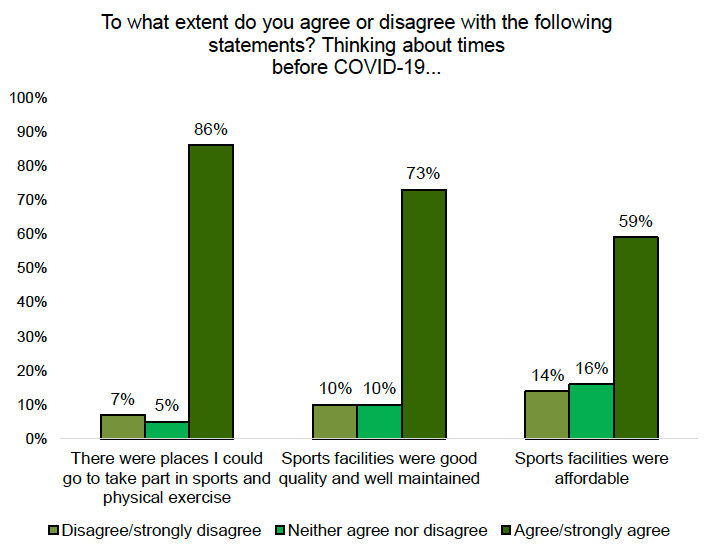
3.7.3 Child poverty
- Across all islands, 3% of respondents said that they had used a food bank or support system, and another 2% stated 'Prefer not to say'. The 'Yes' percentage was somewhat higher in Arran, Bute and the Cumbraes, and Skye and the Small Isles.
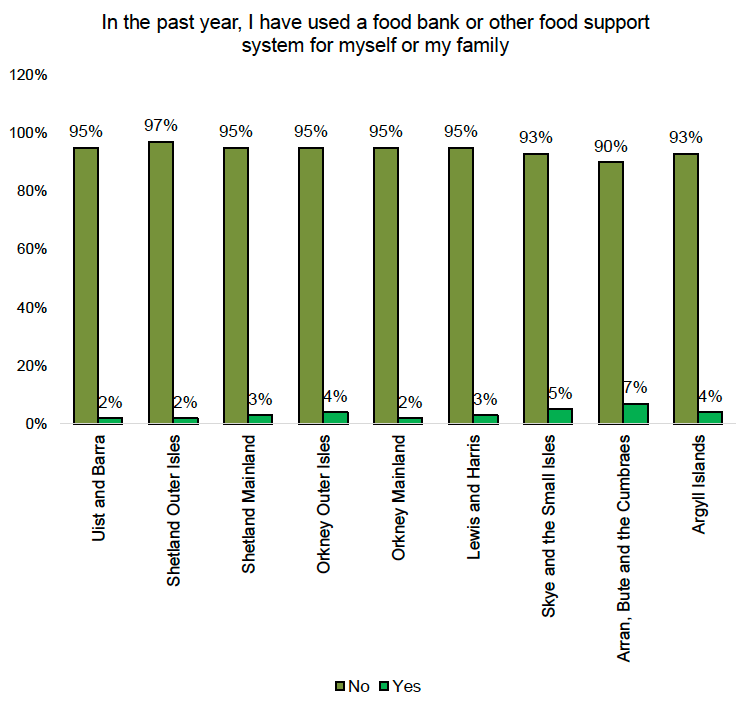
3.8 Environmental wellbeing and climate change
Islanders rate their local environment very highly, and high proportions engage in pro-environmental behaviours, notably buying food locally and generating their own renewable energy, which is particularly common in the Orkney Outer Isles.
Lower proportions of residents report that the local environment is clean and litter-free, however, and the ability to dispose of bulky household waste is a particular issue in the outer islands of Orkney and Shetland.
3.8.1 Environment
- Island residents agree that the air quality is good (98%), they see a lot of wildlife (91%) and there are green or blue spaces within a 5-minute walk of their home (91%), however just 67% of residents agree that their local environment is clean and litter free.
- Just 55% of residents of Arran, Bute and the Cumbraes say that their environment is clean and litter free, significantly lower than the rest of the island regions.
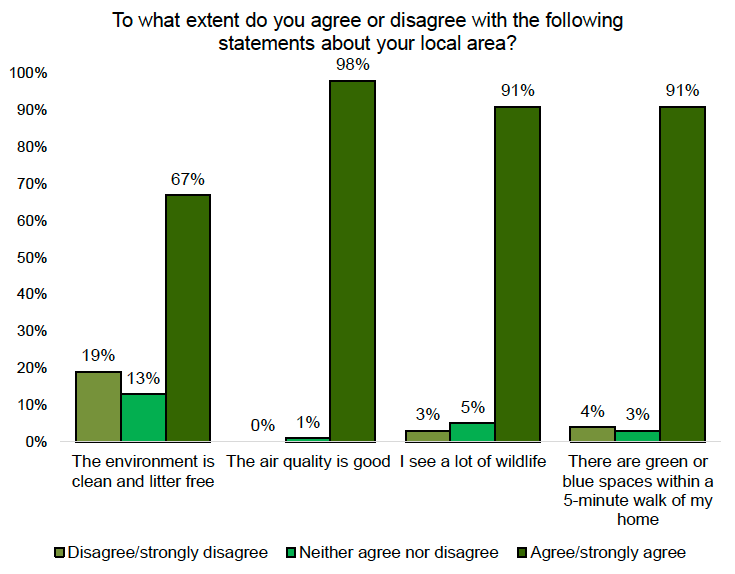
3.8.2 Waste
- Residents in Orkney's Outer Isles are least satisfied with their recycling facilities, with only 46% reporting that it is easy to recycle household waste (glass, plastic, cans and paper), significantly lower when compared to 88% in Shetland's Outer Isles.
- Residents report mixed experiences of disposing of bulky household waste, with less than half agreeing that it is easy to dispose of and significantly low agreement in Shetland Outer Isles (13%) and Orkney Outer Isles (22%).
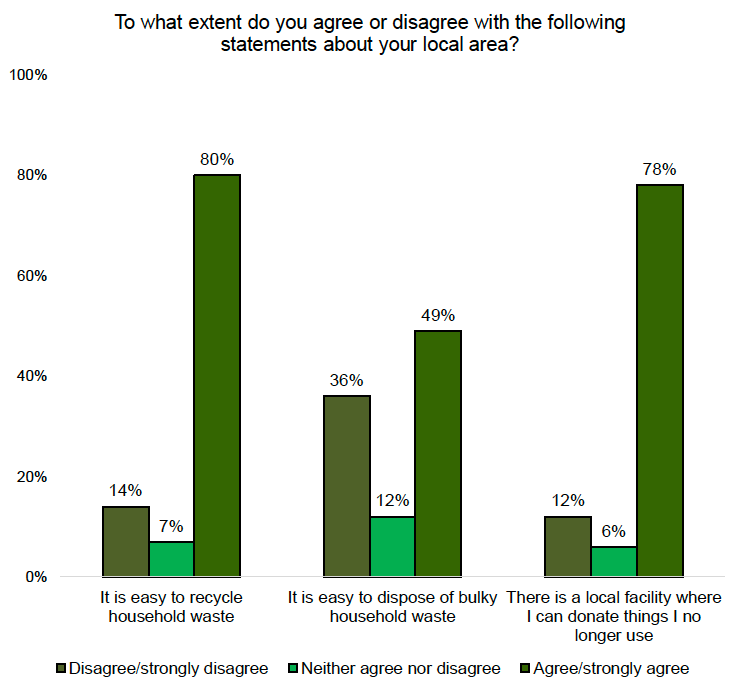
3.8.3 Emissions
- A large proportion of islanders use LED bulbs in their home (85%) and buy food from local sources (82%). 3% use electric vehicles.
- A minority of island residents are members of an environmental organisation, with a slight but significant increase in membership with age: 6% of 18 to 35-year-olds compared to 12% of those aged 66 and over.
- 15% of island residents have installed equipment to generate renewable energy for use in their home. Proportions are significantly higher in Orkney Outer Isles (36%) and Orkney Mainland (22%) than other island regions.
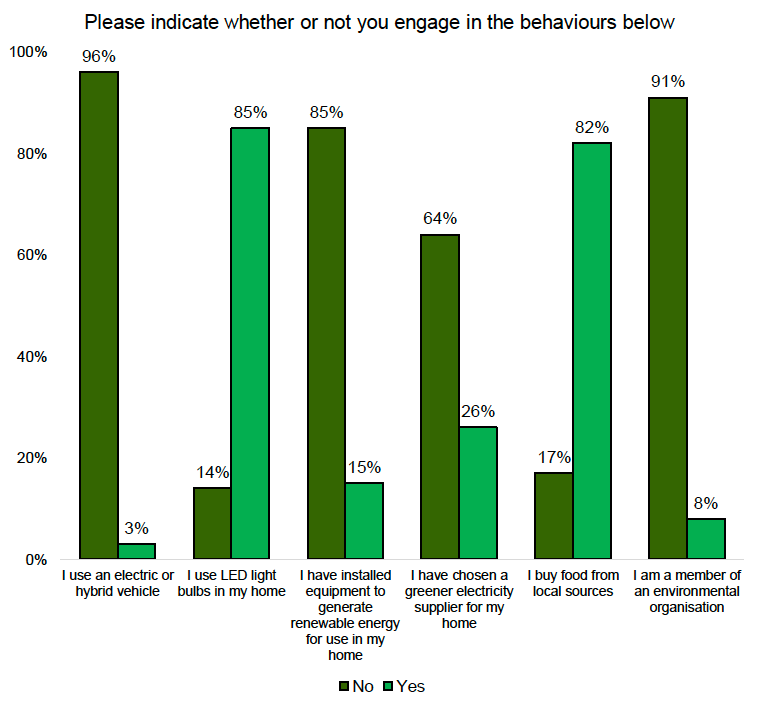
3.9 Empowering communities
Islanders, particularly young islanders, have a greater sense of empowerment within their own communities than they do at regional or national level. Island residents generally have a strong sense of belonging to their local area, but sense of community is stronger in some areas than others.
3.9.1 Involvement in decision-making
- Island residents generally perceive that they have little influence over decisions made by local and national organisations, and more influence over community organisations and community councils, particularly in the Outer Isles of Orkney and Shetland, where around half of residents feel they can influence decisions made by their community council.
- 42% of younger people (aged 18 to 35) compared to 30% of older people (aged 66 and over) report that they can influence decisions made by community organisations such as Development Trusts and community groups.
- Most island residents (82%) see themselves as belonging to their local community.
- The 18-35 age group were significantly less likely to agree with this statement (77%) than the other age groups.
- The majority of island residents (84%) agree that there are physical spaces where the community can come together.
- Agreement was significantly higher in the Orkney Outer Isles (97%) and the Shetland Outer Isles (96%).
- A lower percentage of island residents (69%) agree that there is a strong sense of community.
- Agreement significantly varies between the lowest levels in Lewis and Harris (64%) and the highest in Shetland Outer Isles (81%).
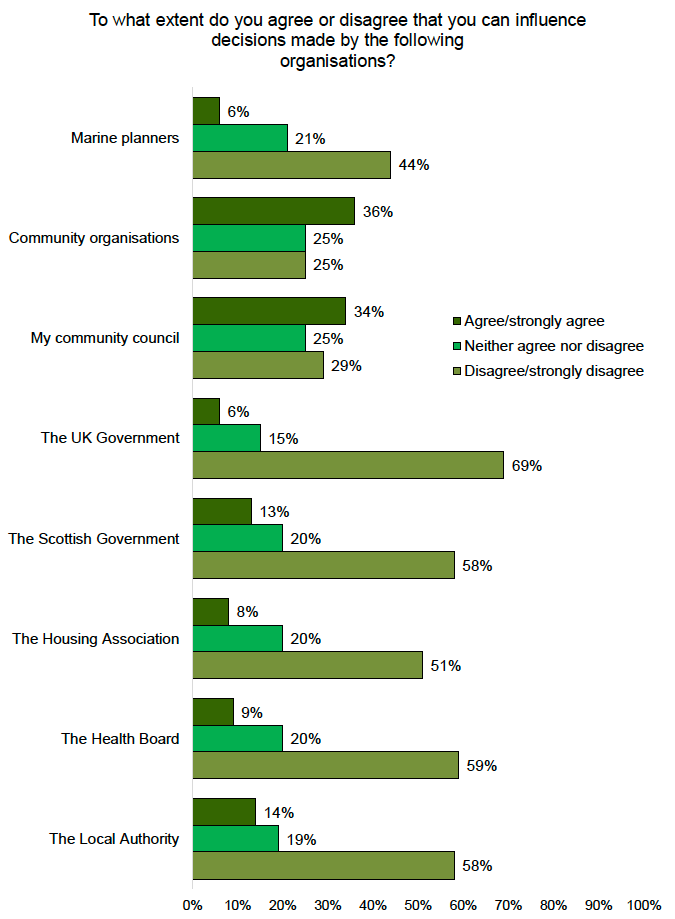
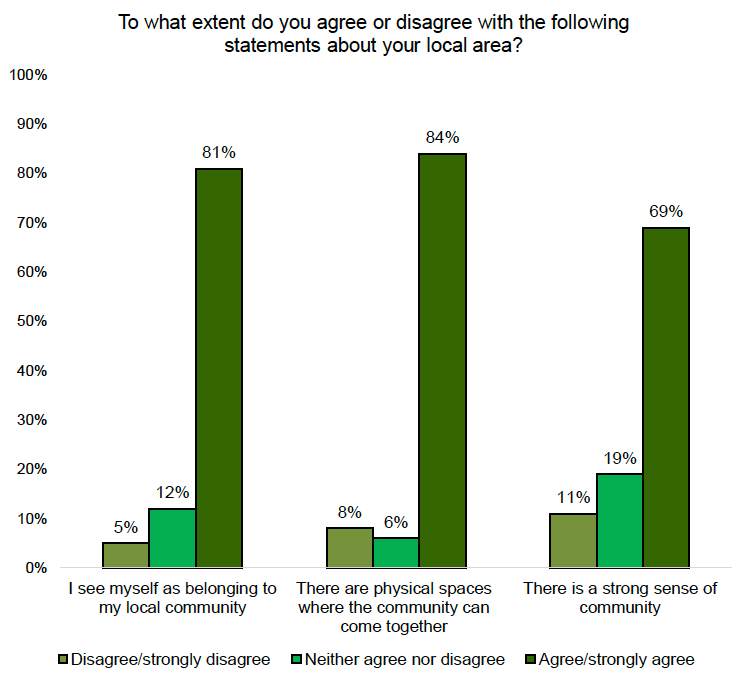
3.10 Arts, culture and language
Experiences of culture and language vary considerably across island groups, age groups and genders, with different patterns of cultural participation and perceptions of the extent to which island culture is supported. Of note, residents of Orkney Mainland and Shetland Mainland are most likely to feel that there is investment in cultural and historic places, and that islanders' creative talents are supported and nurtured.
Those who speak Gaelic have mixed views on how much they are able to use the language in their community, with residents of Lewis and Harris most likely to report that they can use Gaelic in a range of situations. Younger people are more likely to speak and understand Gaelic than older people.
3.10.1 Participating in arts and culture
- 59% of residents agree that there is investment in cultural and historic places and facilities in their island.
- Agreement was significantly higher in Orkney Mainland (80%) and Shetland Mainland (70%).
- The 18 to 35 age group reported the highest level of agreement in comparison to other age groups (66%).
- 58% of residents agree that islanders' creative talents are supported and nurtured.
- Agreement was highest in Orkney Mainland (72%) and Shetland Mainland (74%).
- The 18-35 age group reported the highest agreement in comparison to other age groups (66%).
- The most popular forms of cultural participation for islanders are the cinema (including mobile), with 41% of islanders attending more than once a year, culturally specific festivals (39%), historic places (38%) and live music events (37%).
- Different islands have different patterns of participation, however. People living in Shetland Mainland and Orkney Mainland have higher rates of attendance at culturally specific events (59% and 49% respectively attend more than once a year) and at live music events, which 43% and 40% of respondents do at least once a year.
- Orkney Outer Isles (50%) and Uist and Barra (42%) have the significantly higher attendance at ceilidhs or community dances.
- Young people aged 18 to 35 are more likely to go to live music events more than once a year (40%), ceilidhs or community dances (31%), visit historic places (42%) or go to a culturally specific festival (48%) than those aged 66 and over.
- However, older people aged 66 and over are more likely to visit an exhibition (29%), art gallery (20%), museum (27%) or library (38%) than younger people aged 18 to 35.
- There are also distinct gender differences, with female residents significantly more active than male residents. Female residents are also more likely to go to the cinema (43%), the library (39%) and the theatre (20%) more than once a year than male residents.
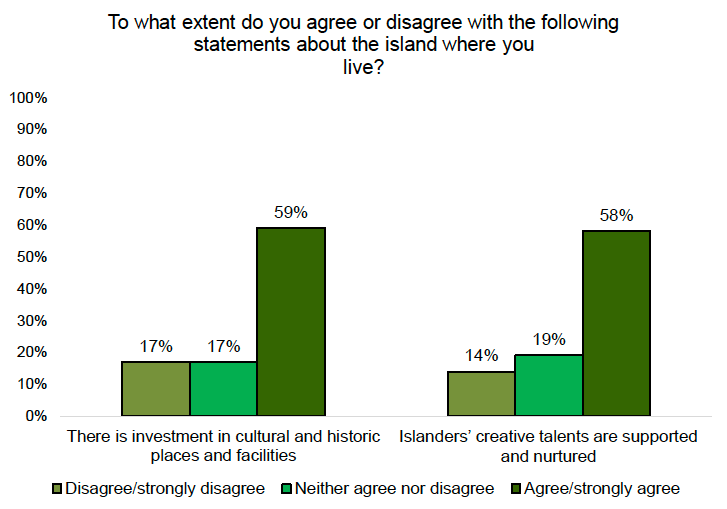
Table 6. Cultural participation
| Thinking about times before COVID-19 and lockdown (before March 2020), how often did you go to this type of event or place? | ||||||
|---|---|---|---|---|---|---|
| Never | Less than once a year | Once a year | Several times a year | At least once a month | At least once a week | |
| Cinema (including mobile) | 21% | 18% | 20% | 35% | 5% | 1% |
| Library (including mobile and online) | 41% | 18% | 9% | 21% | 9% | 2% |
| Live music event | 21% | 18% | 24% | 34% | 3% | 0% |
| Theatre, e.g. pantomime, musical, play | 37% | 20% | 27% | 15% | 1% | 0% |
| Ceilidh or community dance | 35% | 20% | 22% | 23% | 0% | 0% |
| Dance show/performance, e.g. ballet | 61% | 19% | 15% | 5% | 0% | 0% |
| Historic place | 21% | 18% | 23% | 33% | 4% | 1% |
| Museum | 26% | 24% | 26% | 22% | 2% | 0% |
| Art gallery | 42% | 21% | 18% | 17% | 2% | 0% |
| Exhibition, including art, photography and crafts | 30% | 22% | 24% | 23% | 1% | 0% |
| Culturally specific festival | 16% | 11% | 34% | 38% | 1% | 0% |
| Streaming of a live performance | 68% | 14% | 10% | 7% | 1% | 0% |
3.10.2 Scotland's indigenous languages
- The highest proportions of Scottish Gaelic speakers are in Uist and Barra (62%), Lewis and Harris (48%) and Skye and the Small Isles (33%).
- Of those who speak Gaelic, 59% agree that there is support for Gaelic speakers to live and work in their community, 47% that they could access public services in Gaelic, and 34% that they can contribute to decisions affecting their local area in Gaelic.
- Respondents in Lewis and Harris are most positive about these measures.
- Rates of reading and writing Gaelic are significantly higher among people aged 18-35 than other age groups. Rates of understanding Gaelic are also significantly higher in young people than older people aged 66 and over. There were no significant differences found in speaking rates across age groups.
- The highest proportions of speakers of a local dialect are in Shetland Outer Isles (76%), Orkney Mainland (70%), Shetland Mainland (68%) and Orkney Outer Isles (42%).
- Rates of speaking, understanding, reading and writing in local dialects are highest among people aged 18-35, although not significantly different to other age groups.
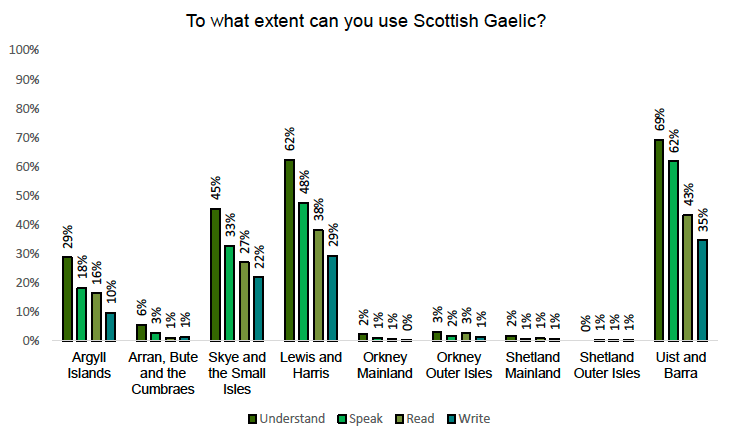
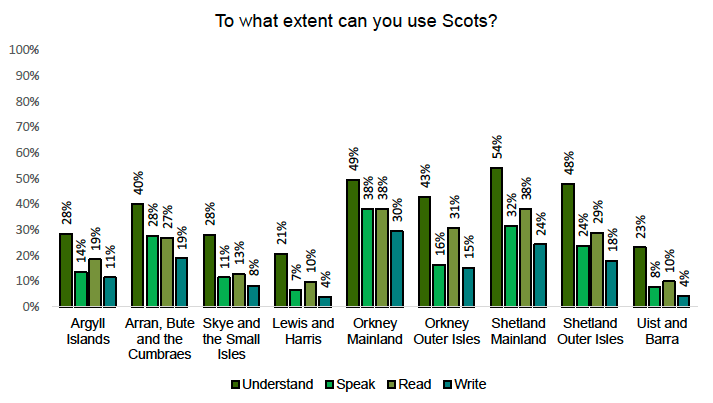
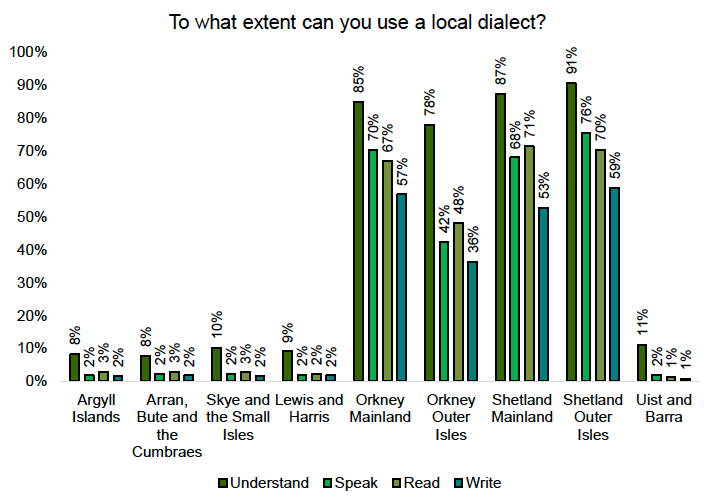
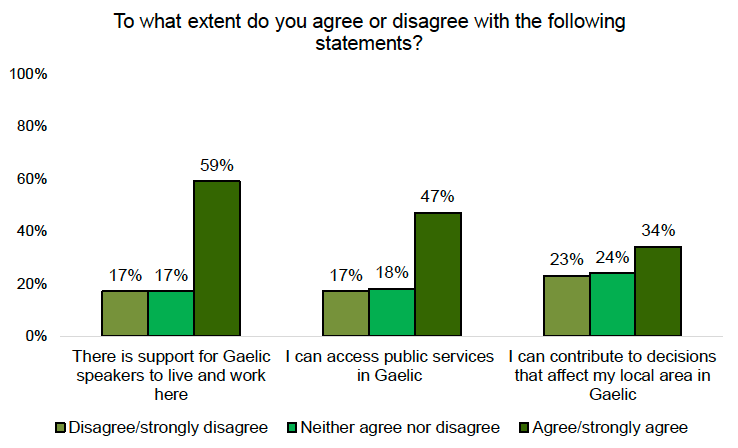
3.11 Education
Perceptions of the quality of education available locally are very positive with regard to primary education but decrease notably in some islands in relation to secondary education, likely due to limited subject availability.
Agreement rates with respect to college and university education and professional qualifications are successively lower, with more positive perceptions among those living in island groups where there are small towns.
3.11.1 Educational opportunities
- Most islanders (89%) agree that children living there have access to good quality primary school education.
- The highest agreement came from Orkney Mainland (95%), Shetland Mainland (95%) and Shetland Outer Isles (92%). In comparison, the Orkney Outer Isles had one of the lowest levels of agreement (81%) along with Uist and Barra (80%).
- Three quarters of islanders agree that children living on the islands can access secondary school education that offers a wide range of subjects (online or in person).
- Argyll Islands (57%), Uist and Barra (57%) and Arran, Bute and the Cumbraes (59%) had significantly lower levels of agreement.
- 69% of islanders agree that they could do a college qualification in a subject of their choice while living on the islands (online or in person).
- Island groups with population centres reported higher levels of agreement: Orkney Mainland (77%), Lewis and Harris (75%), and Shetland Mainland (74%).
- Just over half of all respondents agreed that, if they wanted to, they could do a university degree in a subject of their choice while living on the islands (online or in person).
- Again, highest agreement was found among island groups with population centres: Lewis and Harris (62%) and Orkney Mainland (59%).
- 18 to 35-year-olds reported significantly lower levels of agreement (48%) with this measure than other age groups.
- Less than half of islanders agreed that, if they wanted to, they could access professional training while living on the islands (online or in person).
- Agreement was higher in the Orkney Mainland (61%), Shetland Mainland (54%), and Lewis and Harris (54%).
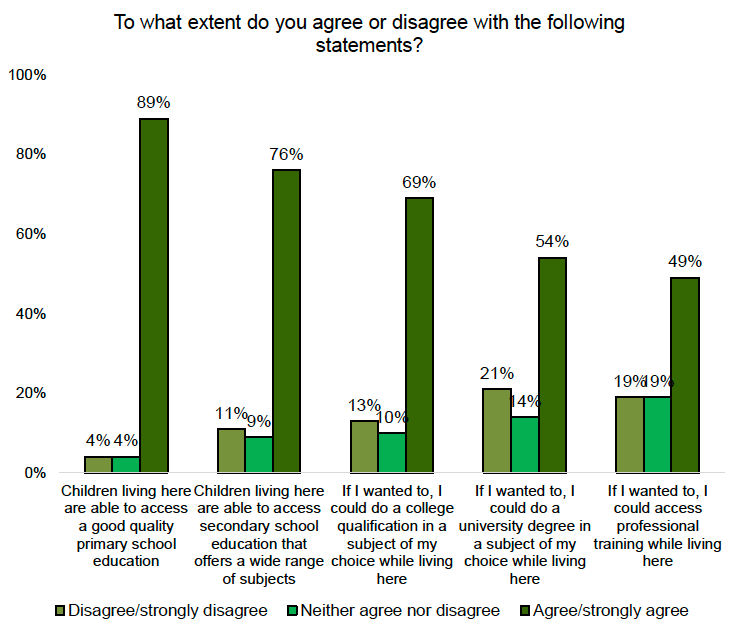
Methodological note
The survey sought the views of island residents about aspects of island life. The findings therefore relate to islanders' perceptions.
For the purposes of summarising, "agree" and "strongly agree" responses have been combined in an "overall agreement" figure, referred to in the headline findings.
The survey was carried out during the autumn and early winter of 2020, when lockdown restrictions were in place. Several of the questions asked respondents to consider their experiences before the Coronavirus (COVID-19) pandemic, to provide comparable baseline data for future surveys.
Contact
Email: socialresearch@gov.scot
There is a problem
Thanks for your feedback